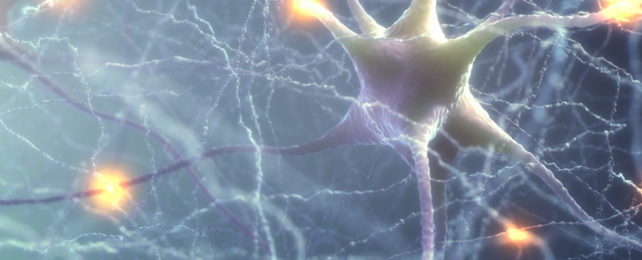Despite the decades of time and billions of dollars being invested in studying Alzheimer's disease, aspects of its development remain stubbornly mysterious. Researchers have chased down many leads, from gum disease to autoimmune disorders.
The original (and now controversial) hypothesis of amyloid plaques playing a central role in the condition's emergence seemed like a promising path to follow, but drugs that targeted these plaques have provided unclear outcomes in clinical trials.
Now, using a mouse model of Alzheimer's disease, a team from Yale University in the US may have figured out why the patches of protein seem relevant without necessarily being directly responsible.
"We found that hundreds of axons develop [swelling] around each amyloid deposit," Yale University neurobiologist Peng Yuan and colleagues write in their paper.
They found the swelling is formed by a buildup of lysosomes – little bin-bag-like compartments created by cells to break down waste and contain it until it can be removed. These lysosomes clump into spheroid structures along the axons of brain cells – the long 'transmission cable' that extends from the cell's body, and ends in branches of signal-sending extensions.
These swellings are thought to disrupt the brain cell's abilities to conduct the electrical signals which are vital for the formation and consolidation of memories.
Using calcium and voltage imaging of individual cells, the team were able to show the amount of signal disruption was linked to the spheroid sizes. The spheroid swellings remain stable for long periods of time, so likely continue to disrupt neuron connectivity.
The size and numbers of the spheroids seen in a small number of post-mortem human brain samples that Yuan and colleagues were able to analyze also correlated with levels of cognitive decline. In other words, those with more severe Alzheimer's disease had more swollen spheroids.
"Given the similarity in the morphology, organelle and biochemical content of [spheroids] in mice and humans, it is probable that, in humans, these are also stable structures that could disrupt neural circuits for extended intervals," the researchers explain.
Yuan and team found that a protein called PLD3 was highly expressed in the spheroids. Mice engineered to lack a PLD3 gene did not produce the same lysosome buildup, and presented reduced levels of swelling on their neurons.
The team found that high levels of PLD3 occasionally led to lysosome enlargement even in healthy mice. However, it was more pronounced in the spheroids located near the amyloid plaques in the mice with Alzheimer's, suggesting something about the plaques exacerbates the swelling process.
These final links need further investigation to confirm.
"It may be possible to eliminate this breakdown of the electrical signals in axons by targeting PLD3 or other molecules that regulate lysosomes, independent of the presence of plaques," explains Yale University neuroscientist Jaime Grutzendler.
While these findings are a hopeful lead, it is still early days and the researchers have already identified studies suggesting some conflicting results in how the PLD3 lysosome changes work in mice and human HeLa cells.
As we've seen before with Alzheimer's, things may prove to still be more complicated, yet again.
"We have identified a potential signature of Alzheimer's which has functional repercussions on brain circuitry, with each spheroid having the potential to disrupt activity in hundreds of neuronal axons and thousands of interconnected neurons," summarizes Grutzendler.
This research was published in Nature.
